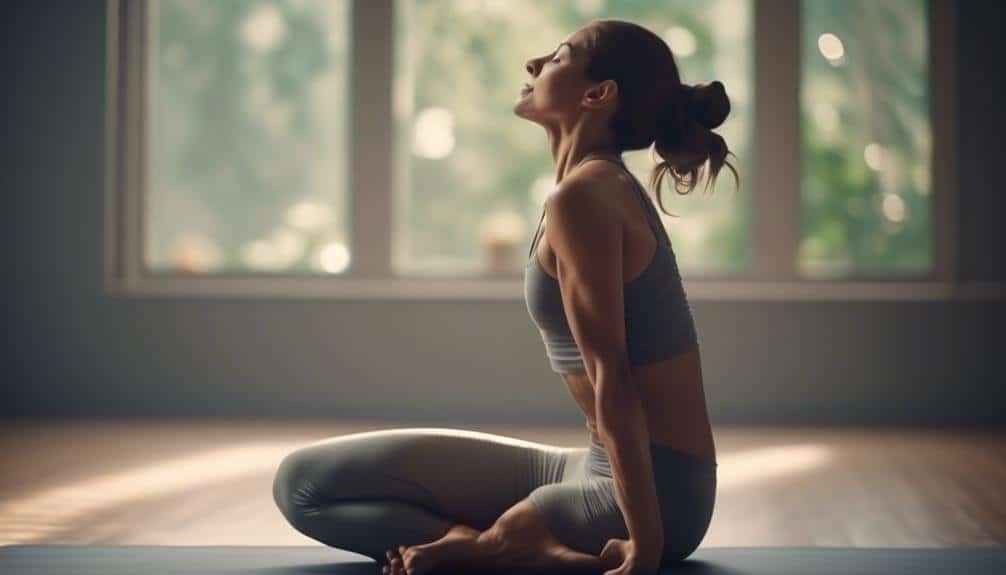How Can I Become More Flexible, Both Physically and Mentally?
So, you've noticed that as you get older, your body feels a bit stiffer and your mind less adaptable than it used to be. You're not alone in this feeling, and the good news is that there are ways to improve both physical and mental flexibility.
By making some simple adjustments in your daily routine and mindset, you can start to see significant changes in your overall flexibility. But how exactly can you achieve this?
Let's explore some practical strategies that can help you become more flexible, both physically and mentally.
Key Takeaways
- Regular stretching exercises targeting different muscle groups can improve physical flexibility and reduce the risk of injuries.
- Cultivating a flexible mindset and open-mindedness is important for mental flexibility and personal growth.
- Incorporating stretching and yoga into your routine can improve physical flexibility and mobility, as well as enhance mental flexibility and relaxation.
- Practicing mindfulness and meditation can improve self-awareness, reduce stress, and enhance concentration and cognitive abilities.
Understanding Physical Flexibility
To increase your physical flexibility, it's essential to engage in regular stretching exercises that target different muscle groups throughout your body.
Dynamic stretching, which involves moving parts of your body and gradually increasing the reach and speed of movement, can be particularly beneficial. It not only improves flexibility but also enhances your overall performance in physical activities.
Additionally, physical therapy can provide personalized stretching exercises to address specific flexibility issues. These exercises are designed to gradually increase the length and flexibility of muscles and tendons.
By incorporating dynamic stretching and physical therapy into your routine, you can effectively improve your physical flexibility.
Embracing Mental Flexibility
As you work on improving your physical flexibility, it's important to recognize that mental flexibility is equally crucial for your overall well-being and personal growth.
Embracing a flexible mindset and open-mindedness can greatly impact your mental flexibility. A flexible mindset allows you to adapt to new situations, consider different perspectives, and approach challenges with creativity. It involves being open to change, willing to learn from experiences, and embracing uncertainty with resilience.
Cultivating mental flexibility can lead to reduced stress, improved problem-solving abilities, and enhanced emotional well-being. Embracing open-mindedness encourages you to explore diverse ideas, accept feedback, and engage in constructive discussions. It enables you to break free from rigid thinking patterns, fostering a greater sense of adaptability and understanding.
Incorporating Stretching and Yoga
When it comes to becoming more flexible physically and mentally, incorporating stretching and yoga into your routine can be incredibly beneficial.
Stretching helps improve flexibility and mobility, while yoga promotes mindfulness and relaxation.
Stretching for Flexibility
Incorporating stretching and yoga into your routine can significantly improve your physical and mental flexibility, allowing you to move more freely and feel more centered.
Dynamic stretching, which involves moving parts of your body and gradually increasing reach and speed of movement, can help to warm up your muscles and prepare them for activity. This type of stretching can improve your range of motion and flexibility, making it a great addition to your exercise routine.
On the other hand, static stretching involves holding a stretch for a period of time, which can help to lengthen and relax your muscles, increasing your overall flexibility.
Incorporating both dynamic and static stretching into your routine, along with yoga, can lead to increased physical flexibility while promoting mental relaxation and focus.
Yoga for Mindfulness
To cultivate mindfulness and enhance both your physical and mental flexibility, incorporating yoga into your routine can be incredibly beneficial. Yoga not only provides physical stretching and strength building but also offers an opportunity to connect with your mind and spirit.
Here are some ways yoga can help you achieve mental clarity and reduce stress:
- Meditation Techniques: Yoga often incorporates meditation and breathing exercises that can help calm your mind, reduce stress, and improve mental focus.
- Stress Reduction: The combination of physical movement and mindfulness activities in yoga can help alleviate stress and promote a sense of inner peace.
- Mindfulness Activities: Engaging in yoga encourages you to be present in the moment, fostering a deeper connection between your body and mind, leading to mental clarity.
Incorporating yoga into your life can lead to a more flexible body and a more resilient, focused mind.
Cultivating Mindfulness Practices
You can start cultivating mindfulness practices by incorporating breathing exercises, which can help you become more aware of your thoughts and emotions.
Body scan meditation practice is another great way to develop mindfulness, as it allows you to focus on each part of your body and observe any sensations without judgment.
These practices can help you cultivate a greater sense of self-awareness and improve your ability to stay present and focused in the moment.
Breathing Exercises for Mindfulness
Mindfulness can be cultivated through simple yet powerful breathing exercises that help you connect with the present moment and promote a sense of calm and balance in your life. Deep breathing and relaxation techniques are essential components of mindfulness practices. Here's how you can incorporate breathing exercises into your daily routine for improved mindfulness:
- Box Breathing: Inhale for a count of 4, hold for 4, exhale for 4, hold for 4, and repeat.
- Mindful Breathing: Focus on the sensation of your breath entering and leaving your body, bringing your attention back whenever it wanders.
- Counted Breathing: Inhale slowly, counting to 4, then exhale for a count of 6, gradually increasing the exhale count for deeper relaxation.
These exercises can help you cultivate mindfulness and bring about a greater sense of peace and presence in your daily life.
Body Scan Meditation Practice
When practicing body scan meditation, gently guide your attention through each part of your body, noticing any sensations or areas of tension without judgment. Body scan meditation is a form of mindfulness meditation that cultivates body awareness.
By systematically bringing attention to each area of the body, from the toes to the head, you can develop a deep sense of presence and connection with your physical self. As you engage in this practice, you may become more attuned to the signals your body is sending, allowing you to address areas of discomfort or tension with compassion and care.
This increased body awareness can also have a positive impact on your mental flexibility, helping you to become more in tune with your emotions and thoughts. Committing to regular body scan meditation can support your journey towards greater physical and mental flexibility.
Engaging in Cognitive Exercises
Engage your mind with cognitive exercises to enhance your mental flexibility and acuity. These exercises can help sharpen your cognitive abilities and improve your problem-solving skills. Here are some activities to get you started:
- Brain Games: Playing brain games such as Sudoku, crossword puzzles, or memory games can challenge your mind and improve your concentration.
- Concentration Exercises: Practicing mindfulness meditation or focusing on a single task for an extended period can enhance your ability to concentrate and stay present.
- Problem Solving and Critical Thinking: Engage in activities that require critical thinking, such as solving riddles, logic puzzles, or strategy games, to stimulate your problem-solving skills and expand your cognitive flexibility.
Sustaining Flexibility in Daily Life
To sustain flexibility in your daily life, integrate regular stretching and movement exercises to maintain your physical and mental agility. Flexibility routines should become an integral part of your daily routine. Incorporate short stretching sessions into your morning or evening rituals.
Take short breaks during your workday to stand up, stretch, and move around. Engaging in activities like yoga or Pilates can also help maintain flexibility and balance.
It's essential to find a work-life balance that allows you to prioritize physical and mental well-being. Flexibility in both your body and mind is crucial for stress management.
Conclusion
So, in conclusion, it's time to start bending and stretching, both physically and mentally.
Embrace the art of flexibility, and incorporate stretching and yoga into your routine.
Cultivate mindfulness practices and engage in cognitive exercises to keep your mind agile.
Remember, flexibility is a valuable skill in navigating life's twists and turns.
Keep practicing and sustaining flexibility in your daily life, and watch as you become more adaptable and resilient in mind and body.
Keep up the great work!






